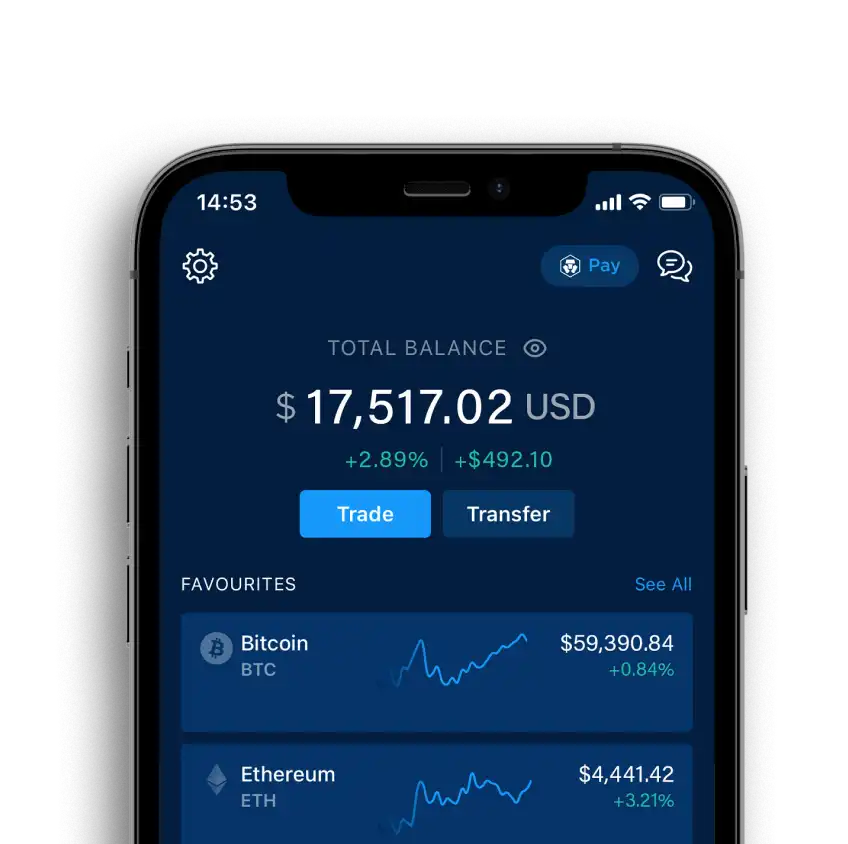
How to Use ‘Earn’ Features in the Onchain App
From staking to lending and liquidity pools, learn how DeFi can earn you interest on your crypto holdings

Decentralised finance, or DeFi, is one of the major pillars of the crypto industry. Built on smart contracts for automation, DeFi offers fast transactions and wide accessibility to financial services to almost anyone with an Internet connection.
For more information on DeFi, check out our intro to DeFi.
Users can access DeFi projects through decentralised apps, also known as dapps. One of their appeals are so-called ‘earn’ features that give users the opportunity to earn interest on their crypto holdings.
Here, we explain how to use five of the most popular DeFi functions in the Crypto.com Onchain App, step by step.
Learn how to:
- Stake & Lock-up
- Use a liquidity pool
- Lend
- Use a stablecoin protocol
- Use a yield optimiser
Before starting, consider downloading the Crypto.com Onchain App, as it is referenced throughout this article. The wallet is a great first point of contact for DeFi and a one-stop shop for multiple DeFi projects and platforms.
1. Staking on DeFi Protocols
A popular mechanism in DeFi is staking, which is a strategy that typically involves locking a crypto asset on a blockchain for a return. The Crypto.com Onchain App offers over 20 tokens that can be staked or locked-up easily in the DeFi ‘Earn’ tab. VVS Finance is the most popular DeFi platform that users stake within the DeFi Wallet.
Staking on VVS Finance
VVS stands for ‘Very, Very Simple’ (VVS) Finance, and it is the leading decentralised exchange (DEX) on Cronos. The VVS token is the native token of VVS Finance. This DEX offers a unique staking feature that can earn users xVVS tokens.
Users can purchase and deposit VVS on Crypto.com Onchain to receive a yield-bearing token, known as xVVS, in return. On VVS Finance users can deposit these yield-bearing tokens for an added bonus.
Once users have deposited xVVS tokens, they can lock them in the vaults for a certain amount of time to increase potential rewards. VVS promises xVVS holders a portion of all fees generated on the platform.
Step-by-step instructions on how to acquire xVVS and stake in the DeFi Wallet:
- Open the Onchain App and purchase VVS tokens
- Open the DeFi browser at the bottom of the app
- Under the ‘Popular’ heading, click ‘VVS Finance’
- Once on the VVS Finance page, click on ‘Earn’ at the bottom, then select ‘xVVS’
- Enable the ‘Stake’ pool and follow the prompts to deposit your VVS
- Once completed, users receive xVVS tokens in return
- Select ‘Vault’ on the page
- Enable the vault and select your desired lock-up period under xVVS Vault Fixed Term: 1 Week, 6 Months, 12 Months, or 48 Months
- Follow the prompts and deposit your xVVS
2. Using a Liquidity Pool
A liquidity pool is typically a set of two coins that are kept on a DEX as a trading pair. It allows users to provide their funds to a protocol for liquidity, thus becoming liquidity providers (or LPs) and receive incentives in return. These are usually in the form of a portion of the platform’s generated trading fees that are allocated back to the LP.
As with any market, there are risks, such as impermanent loss (IL), which can occur after depositing your assets into a liquidity pool and the price of the tokens rises or decreases.
For more information on IL, check out this article.
For example, let’s look at VVS Finance and its VVS token, which can be used in a liquidity pool, such as the VVS-CRO liquidity pool. Below we show how to deposit into a VVS-CRO liquidity pool.
On VVS Finance, liquidity pools can be found in the Crystal Farms. Before starting, ensure there is enough VVS in your wallet; otherwise, swap for some VVS in the DeFi Wallet under the ‘Swap’ section.
Step-by-step instructions on depositing into a VVS-CRO liquidity pool on VVS:
- Open the Onchain App and click on the ‘Earn’ section
- Navigate to the ‘Earn More’ tab
- From there, select ‘VVS Finance’
- Select the ‘vvs.finance’ protocol
- Choose ‘VVS-CRO’
- Select ‘Swap Now’
- Swap your VVS for VVS-CRO LP tokens and then select ‘Confirm Swap’
- Once the swap is complete, click ‘Confirm Deposit’
- Your CRO-VVS LP tokens are now deposited
- Users are able to see their funds on the ‘Earn’ page
The VVS-CRO liquidity pool is just one of many that can be found in the Crystal Farms. In total, there are over 10 different pairs to choose from, including CRO-USDT, CRO-USDC, CRO-TONIC, CRO-ETH, VVS-CRO, VVS-USDT, VVS-USDC, VVS-SINGLE.
3. Lending Your Crypto Assets
Lending and borrowing is the foundation of DeFi. On many protocols, users provide their cryptocurrency on a platform that lends these funds to other users. Lent funds can generate yield in the form of tokens.
To learn more about lending and borrowing in DeFi, read our intro to the basics of DeFi.
A leading lending protocol on the Cronos blockchain is Tectonic, which allows users to lend assets and receive a return on them. The protocol also allows users to borrow a wide variety of different cryptocurrencies in an over-collateralised manner. Overcollateralised means the user provides more than the amount they wish to borrow.
Step-by-step instructions on how to provide CRO to Tectonic:
- Navigate to the browser in the Onchain App
- From the browser, select ‘Tectonic’
- From the list of coins on the homepage, select ‘CRO’
- Click ‘Supply’ and enter how much you would like to provide
- Enable the use of CRO on the platform and confirm the supply
- Your CRO is now supplied on Tectonic and you are able to earn on the assets you provided
Users will notice two different return rates. The distributed annual percentage yield (APY), which is the rate of return, gives rewards in TONIC, Tectonic’s native coin; whereas, the supply APY gives a return in the token that is supplied.
4. Using a Stablecoin Protocol
Stablecoins are pegged to a fixed value, such as the US dollar. An example of a stablecoin is USD Coin (USDC).
For more information on stablecoins, check out ‘What Are Stablecoins and How Do They Work?’.
Ferro is a stablecoin protocol and DEX where users can exchange stablecoins with ‘low chance of slippage’.
Slippage is a change in the price of an asset while trading. When users trade on a DEX, they commit to swapping the assets at a specific price. Unfortunately, the DEX can’t always guarantee that exact price the user inputs, so the slippage is the difference between the price the user originally agreed upon and the actual price when the trade was executed.
Ferro currently offers one pool with three different stablecoins: USDC, USDT, and DAI. The most seamless way to provide liquidity on the Ferro protocol is through the DeFi ‘Earn’ section in Onchain, where Ferro is natively integrated (i.e., you can deposit into the protocol right in your Onchain App without having to visit another dapp).
How to Supply Assets on the Ferro Protocol
- Open the Onchain App and purchase USDC
- With your USDC obtained, head to the bottom right, select ‘Earn’ and then ‘Earn More’
- Select ‘USDC’ and then ‘Ferro Protocol’
- Select the ‘USDC-USDT-DAI’ pool and select ‘Swap Now’
- Swap the USDC into the USDC-USDT-DAI LP token and make sure to ‘Confirm Swap’
- Deposit your stablecoins by selecting ‘Confirm Deposit’
- Go to ‘Stake Liquidity’
- Confirm staking of the liquidity and also the necessary transactions
- Once the funds have been staked, users can begin receiving rewards in FER, Ferro’s native token
5. Using a Yield Optimiser
Yield optimisers, such as Mad Meerkat Optimizer and Beefy Finance, auto-compound users’ funds at the most optimal rate to maximise rewards.
How to Earn With Beefy Finance
- Visit Beefy Finance through the DeFi browser
- On the main page, filter the chain to ‘Cronos’ and search for a vault in which you would like to invest
- You’ll need to approve that asset or set of assets before depositing
- On Beefy, because of the ‘Zap’ function, you only need one coin out of a liquidity pool pair. The ‘Zap’ function swaps the coin into even amounts of the pair, making it very streamlined for the user
- Use the ‘Zap’ function to add your assets to the pool
- Follow the necessary prompts and transactions
- Your assets should now be ready to start working for you
As convenient as these autocompounders can be, it’s important to note that some of these protocols charge a fee for withdrawing or when depositing in order to keep the protocol running. With Beefy Finance, there is a performance fee of 4.5% on the rewards that your deposit generates.
Conclusion
DeFi is a notable tool for users to utilise and grow their crypto. Dive into the DeFi space with the Onchain App, a one-stop gateway to currently over 60 different protocols, including those mentioned above.
To learn more about how to get started with DeFi, check here.
Due Diligence and Do Your Own Research
All examples listed in this article are for informational purposes only. You should not construe any such information or other material as legal, tax, investment, financial, or other advice. Nothing contained herein shall constitute a solicitation, recommendation, endorsement, or offer by Crypto.com to invest, buy, or sell any crypto assets. Returns on the buying and selling of crypto assets may be subject to tax, including capital gains tax, in your jurisdiction.
Although the term ‘stablecoin’ is commonly used, there is no guarantee that the asset will maintain a stable value in relation to the value of the reference asset when traded on secondary markets or that the reserve of assets, if there is one, will be adequate to satisfy all redemptions.
Past performance is not a guarantee or predictor of future performance. The value of crypto assets can increase or decrease, and you could lose all or a substantial amount of your purchase price. An increase in the quantity of your crypto assets may not result in a higher fiat value when converted due to Impermanent Loss. When assessing a crypto asset, it’s essential for you to do your research and due diligence to make the best possible judgement, as any purchases shall be your sole responsibility.
Compartir con amigos
Artículos relacionados
Cryptocurrency Trading Pairs: A Beginner’s Guide

Cryptocurrency Trading Pairs: A Beginner’s Guide

Cryptocurrency Trading Pairs: A Beginner’s Guide

What Are Smart Contracts and Why Are They Important for Ethereum?

What Are Smart Contracts and Why Are They Important for Ethereum?

What Are Smart Contracts and Why Are They Important for Ethereum?

Ethereum Wallets: What Are They and Is One Needed?

Ethereum Wallets: What Are They and Is One Needed?

Ethereum Wallets: What Are They and Is One Needed?

¿Todo listo para comenzar tu viaje por el mundo de las criptomonedas?
Obtén tu guía paso a paso para abriruna cuenta con Crypto.com
Al hacer clic en el botón Enviar, reconoces haber leído el aviso de privacidad de Crypto.com donde explicamos cómo usamos y protegemos tus datos personales.







